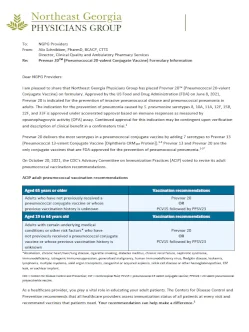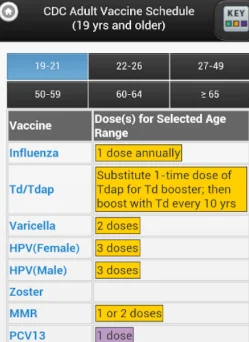Campaign Toolkit

Provider & Staff Education: Level 2
Establish immunization protocols for practice
Establish protocols for optimizing immunizations within your practice by evaluating treatment algorithms against current guidelines and modifying current workflows to address gaps in care and align with best practices. This ongoing process—which can be implemented in phases—is geared toward improving efficiency and vaccination rates.
There are missed opportunities for vaccinations in virtually all practice settings. Your team can address these gaps and get more patients appropriately vaccinated by evaluating and modifying your current workflows and protocols. As you refine these immunization processes, consider the following guidance.
Ensure treatment algorithms align with the most current guidelines
Translating the Centers for Disease Control and Prevention’s (CDC) immunization schedules into practice can be complex. Leveraging tools such as algorithms can aid staff in the relevant decision-making process for appropriately administering routine adult vaccinations. Evaluate your organization’s existing immunization algorithms to ensure they are up to date with the latest guidance. Consider incorporating treatment algorithms into order sets and provider dashboards to follow guidelines for each patient. If your organization hasn’t adopted an algorithm for a given vaccine, the tools at the bottom of this page offer a place to start.
Refine clinical workflows to address gaps in care
Evaluate your current clinical workflows and operations, taking the entire vaccination process into account, including storage, handling, administration, and documentation. Can you make changes to increase efficiency, efficacy, or patient experience? Some innovative examples of workflow improvements may include:
-
Expanding staff responsible for engaging patients in conversations around immunization status (e.g., front-desk staff, staff who room the patients, etc.)
-
Engaging staff in daily huddles to review patients with vaccination care gaps
-
Standardizing the rooming process to include vaccinations
-
Placing vaccine refrigerators or freezers close to patient care areas
-
Organizing vaccines so that staff can grab the correct bottle every time
-
Leveraging standing orders to empower additional staff to administer vaccinations as appropriate
Take a phased approach to implementation
Achieving change at an organizational level is a gradual process. The following are best practices for creating sustainable change:
-
Secure buy-in from relevant stakeholders (e.g., leadership, clinical staff, etc.).
-
Identify organizational goals and develop objectives (don’t forget to review your data during this step!).
-
Start small, with a pilot project in one department or clinic.
-
Spread successful interventions across the organization.
-
Gather feedback and capture lessons learned along the way. Resources like the Plan-Do-Study-Act worksheet by the Institute for Healthcare Improvement can help.
-
Determine a plan for sustainability.
Campaign Planks

PCV-20 Formulary Information Provider Letter
Offers a communication to providers outlining CDC’s new adult pneumococcal vaccination recommendations and describing its application within the practice, including the placement of PCV20 on formulary.

Provider Visit Vaccine Administration Process
Outlines the steps of the vaccine administration process for provider visits in a flow chart. These steps cover all aspects of the process, including scheduling the office visit, checking patient records, disinfecting surfaces, administering the vaccine, and monitoring the patient post-vaccine.

Non-Provider Visit Vaccine Administration Process
Outlines the steps of the vaccine administration process for non-provider visits (e.g., walk-in visit, scheduled nurse only visit) in a flow chart. These steps cover all aspects of the process, including scheduling the office visit, checking patient records, disinfecting surfaces, administering the vaccine, and monitoring the patient post-vaccine.

"Validate Before You Vaccinate" Flyer
Offers a checklist for healthcare staff on the important items to validate before administering a vaccine.

Vaccine Administration Record for Adults
Provides a template vaccine administration record for adults that can be completed with relevant information, including patient name, birthdate, chart number, type of vaccine, date vaccine given, funding source, route and site, vaccine lot number and manufacturer, Vaccine Information Statement provided, and vaccinator.

AMGA Maternal RSV Immunization Implementation Strategy: A Checklist for Providers

CDC Vaccine Schedules Mobile App
Offers quick and easy access to CDC recommended immunization schedules and footnote. Through this app, users can identify correct vaccine, dosage, and timing with two or three clicks.

Recommended Adult Immunization Schedule
Outlines the Centers for Disease Control and Prevention’s 2025 recommended adult immunization schedule for ages 19 years or older.